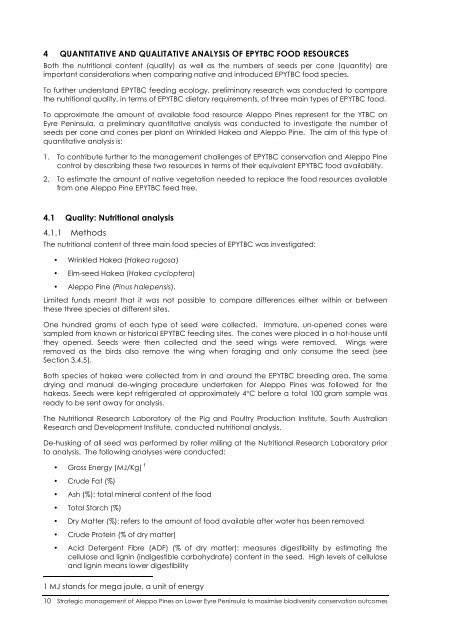Strategic management of Aleppo Pines on Lower Eyre
Strategic management of Aleppo Pines on Lower Eyre
Strategic management of Aleppo Pines on Lower Eyre
You also want an ePaper? Increase the reach of your titles
YUMPU automatically turns print PDFs into web optimized ePapers that Google loves.
4 QUANTITATIVE AND QUALITATIVE ANALYSIS OF EPYTBC FOOD RESOURCES<br />
Both the nutriti<strong>on</strong>al c<strong>on</strong>tent (quality) as well as the numbers <str<strong>on</strong>g>of</str<strong>on</strong>g> seeds per c<strong>on</strong>e (quantity) are<br />
important c<strong>on</strong>siderati<strong>on</strong>s when comparing native and introduced EPYTBC food species.<br />
To further understand EPYTBC feeding ecology, preliminary research was c<strong>on</strong>ducted to compare<br />
the nutriti<strong>on</strong>al quality, in terms <str<strong>on</strong>g>of</str<strong>on</strong>g> EPYTBC dietary requirements, <str<strong>on</strong>g>of</str<strong>on</strong>g> three main types <str<strong>on</strong>g>of</str<strong>on</strong>g> EPYTBC food.<br />
To approximate the amount <str<strong>on</strong>g>of</str<strong>on</strong>g> available food resource <str<strong>on</strong>g>Aleppo</str<strong>on</strong>g> <str<strong>on</strong>g>Pines</str<strong>on</strong>g> represent for the YTBC <strong>on</strong><br />
<strong>Eyre</strong> Peninsula, a preliminary quantitative analysis was c<strong>on</strong>ducted to investigate the number <str<strong>on</strong>g>of</str<strong>on</strong>g><br />
seeds per c<strong>on</strong>e and c<strong>on</strong>es per plant <strong>on</strong> Wrinkled Hakea and <str<strong>on</strong>g>Aleppo</str<strong>on</strong>g> Pine. The aim <str<strong>on</strong>g>of</str<strong>on</strong>g> this type <str<strong>on</strong>g>of</str<strong>on</strong>g><br />
quantitative analysis is:<br />
1. To c<strong>on</strong>tribute further to the <str<strong>on</strong>g>management</str<strong>on</strong>g> challenges <str<strong>on</strong>g>of</str<strong>on</strong>g> EPYTBC c<strong>on</strong>servati<strong>on</strong> and <str<strong>on</strong>g>Aleppo</str<strong>on</strong>g> Pine<br />
c<strong>on</strong>trol by describing these two resources in terms <str<strong>on</strong>g>of</str<strong>on</strong>g> their equivalent EPYTBC food availability.<br />
2. To estimate the amount <str<strong>on</strong>g>of</str<strong>on</strong>g> native vegetati<strong>on</strong> needed to replace the food resources available<br />
from <strong>on</strong>e <str<strong>on</strong>g>Aleppo</str<strong>on</strong>g> Pine EPYTBC feed tree.<br />
4.1 Quality: Nutriti<strong>on</strong>al analysis<br />
4.1.1 Methods<br />
The nutriti<strong>on</strong>al c<strong>on</strong>tent <str<strong>on</strong>g>of</str<strong>on</strong>g> three main food species <str<strong>on</strong>g>of</str<strong>on</strong>g> EPYTBC was investigated:<br />
• Wrinkled Hakea (Hakea rugosa)<br />
• Elm-seed Hakea (Hakea cycloptera)<br />
• <str<strong>on</strong>g>Aleppo</str<strong>on</strong>g> Pine (Pinus halepensis).<br />
Limited funds meant that it was not possible to compare differences either within or between<br />
these three species at different sites.<br />
One hundred grams <str<strong>on</strong>g>of</str<strong>on</strong>g> each type <str<strong>on</strong>g>of</str<strong>on</strong>g> seed were collected. Immature, un-opened c<strong>on</strong>es were<br />
sampled from known or historical EPYTBC feeding sites. The c<strong>on</strong>es were placed in a hot-house until<br />
they opened. Seeds were then collected and the seed wings were removed. Wings were<br />
removed as the birds also remove the wing when foraging and <strong>on</strong>ly c<strong>on</strong>sume the seed (see<br />
Secti<strong>on</strong> 3.4.5).<br />
Both species <str<strong>on</strong>g>of</str<strong>on</strong>g> hakea were collected from in and around the EPYTBC breeding area. The same<br />
drying and manual de-winging procedure undertaken for <str<strong>on</strong>g>Aleppo</str<strong>on</strong>g> <str<strong>on</strong>g>Pines</str<strong>on</strong>g> was followed for the<br />
hakeas. Seeds were kept refrigerated at approximately 4°C before a total 100 gram sample was<br />
ready to be sent away for analysis.<br />
The Nutriti<strong>on</strong>al Research Laboratory <str<strong>on</strong>g>of</str<strong>on</strong>g> the Pig and Poultry Producti<strong>on</strong> Institute, South Australian<br />
Research and Development Institute, c<strong>on</strong>ducted nutriti<strong>on</strong>al analysis.<br />
De-husking <str<strong>on</strong>g>of</str<strong>on</strong>g> all seed was performed by roller milling at the Nutriti<strong>on</strong>al Research Laboratory prior<br />
to analysis. The following analyses were c<strong>on</strong>ducted:<br />
• Gross Energy (MJ/Kg) 1<br />
• Crude Fat (%)<br />
• Ash (%): total mineral c<strong>on</strong>tent <str<strong>on</strong>g>of</str<strong>on</strong>g> the food<br />
• Total Starch (%)<br />
• Dry Matter (%): refers to the amount <str<strong>on</strong>g>of</str<strong>on</strong>g> food available after water has been removed<br />
• Crude Protein (% <str<strong>on</strong>g>of</str<strong>on</strong>g> dry matter)<br />
• Acid Detergent Fibre (ADF) (% <str<strong>on</strong>g>of</str<strong>on</strong>g> dry matter): measures digestibility by estimating the<br />
cellulose and lignin (indigestible carbohydrate) c<strong>on</strong>tent in the seed. High levels <str<strong>on</strong>g>of</str<strong>on</strong>g> cellulose<br />
and lignin means lower digestibility<br />
1 MJ stands for mega joule, a unit <str<strong>on</strong>g>of</str<strong>on</strong>g> energy<br />
10 <str<strong>on</strong>g>Strategic</str<strong>on</strong>g> <str<strong>on</strong>g>management</str<strong>on</strong>g> <str<strong>on</strong>g>of</str<strong>on</strong>g> <str<strong>on</strong>g>Aleppo</str<strong>on</strong>g> <str<strong>on</strong>g>Pines</str<strong>on</strong>g> <strong>on</strong> <strong>Lower</strong> <strong>Eyre</strong> Peninsula to maximise biodiversity c<strong>on</strong>servati<strong>on</strong> outcomes

















